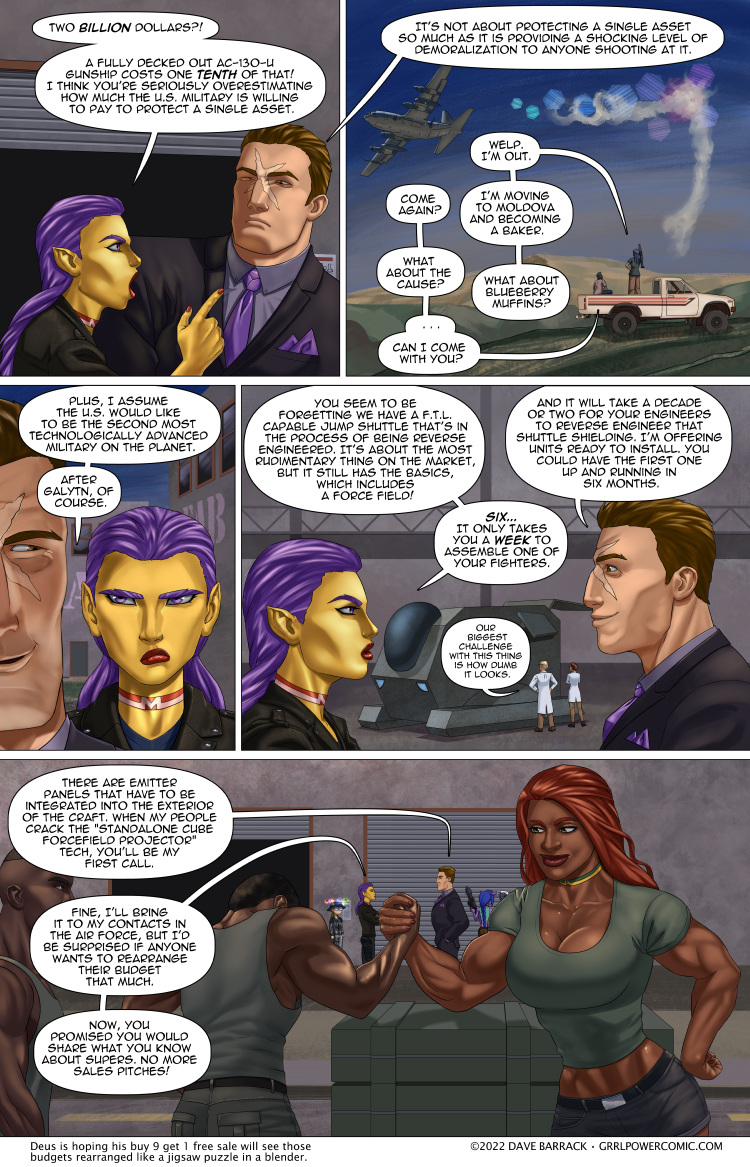Grrl Power #1029 – Sticker shock
The discussion in panel 2 is entirely predicated on the crew of that gunship not returning fire. If I was them, I’d toss a flare into the gas tank of that pickup and dive down the side of the hill and hunker down under a thick blanket. This assumes that as them, I still would have played the gunship sequence of Modern Warfare games and understand how easy it is to spot dudes on infrared. That, or I’d only attack gunships when it was 98.6 degrees out.
You can’t really claim to have the “most advanced military” based on a single piece of tech. If you gave whoever has the least advanced military on the planet (insert joke about Russia’s embarrassing showing in the Ukraine here) and gave them one handheld Phaser, they don’t automatically become the most advanced military all of a sudden. I think it’s really more of an average across your entire force. Deus is just needling Maxima a bit there in panel three, while also implying that other nations might be interested in his tech. I can’t imagine that Japan wouldn’t jump at the chance to have real live force fields. Well, in reality, I think Japan’s diet is probably super conservative, but I like to think their leadership is basically the average homeroom class from any given anime, only 20 years later, meaning that while most of them are pretty forgettable, about a third of them have really formulaic personalities but notable hair. Oh, and at least a few would be interested in force fields.
A lot of discussion about the physics of force field technology on the previous page. That’s always amusing when people get deep into the weeds about fictional tech, cause unless you’re dealing with a long running show that has ample evidence of the tech in action, it’s really all just speculation. And let’s be honest, even then, the way any piece of tech is presented is usually pretty inconsistent, because unless you have some whip-cracking series continuity overlord, the writer from one episode is going to say that transporters can beam up people from within a cave system from geosynchronous orbit, and another writer will say someone stealing a ride from the shuttle bay will be out of transport range in the time it takes Picard to say “Beam them out of that shuttle.”
As an aside, I think the shows that were the best about technology continuity were Stargate SG-1 and The Expanse. To be fair to something like Star Trek, a multi generational franchise has no hope of maintaining any sort of continuity, tech or otherwise, especially when they idiotically keep doing prequel shows. Of course nothing in Enterprise matched established TOS or TNG continuity. Calling it a comic-book-esque alternate timeline/multiverse doesn’t make it any less disappointing.
Anyway.
Obviously airtight spherical shields wouldn’t work on a modern jet or prop plane for a number of reasons. The simple answer to what happened on the previous page is that maybe an appropriately equipped plane sitting on an airfield can form a dome over itself to keep from getting strafed or bombed. This page shows a series of static shields forming to intercept an attack. This method would be much more problematic for front-on attacks, but then maybe the shields blit in and out, creating a static wall that only exists for a microsecond. Actually, it’d probably have to create them 2 or 3 deep to keep stuff from slipping through during the blits.
BTW, I’m looking into what happened to the page header. WordPress updated and who knows? Maybe it doesn’t honor .php includes anymore? It’ll return when I get a chance to dig into the backend a bit.
Tamer: Enhancer 2 – Progress Update: It’s done!
 210K words of weapon building, dinosaur fighting, harem satisfying, lumberjacking, moderate diplomacing, bad guy chopping action. Also some humor.
210K words of weapon building, dinosaur fighting, harem satisfying, lumberjacking, moderate diplomacing, bad guy chopping action. Also some humor.
I got the pencils done for March’s incentive, and I like what I’ve got so far, but it was a multi-character piece and I thought it would take to long to color correctly, so I started over with a single character piece and it’s coming along quite nicely IMO. It just isn’t done yet. If it’s not done for Thursday’s comic, it’ll be up with next Monday’s. The good news is I should have a decent head start for the next incentive, so one of these months I’ll get it up with the first comic of the month.
The vote incentive is up! Lorlara is attempting to break office harassment rules.
Patreon includes some increasingly aggressive fashion choices. Bonus comic page is posted and she no longer has two left feet. Oops.
Double res version will be posted over at Patreon. Feel free to contribute as much as you like.

















Dues so very much wants another bite of that golden apple!
Dave you don’t have to justify force field inconsistencies to us anymore Dabbler’s “depends on the tech level of the field” is more than enough as long you don’t let people in rest who’ve shown to have an ability make plans in the assumption they don’t.
The idea that force fields are airtight is only shown for Sydney’s shield, which has shown to be weird, due to its teleport restrictions, builders and owner.
My “tech analyse” for force fields in grrl power:
They stop particle beams, but it weakens them.
They spread out shock waves over the larger body of the shield.
Some stop teleportation.
They show transparent glowing hexagons when hit.
People can at least go through some.
They can be one way.
Dabbler has stated there are different tech levels of force field.
There exist things like “military grade force fields” and “personal forcefields”
My current “primitive explanation” is that they’re essentially an easily expandable bullet resistant glass dome with propelled weights or strong beams connected a stable underground to handle being hit with a lot of force and an internal repair system that repairs hit areas. All the other properties of force fields are extra features that can added or not. Examples: make frames and moving panels, so the force field becomes one way, place anti-teleportation wars and replace the glass with a see through non-newtonian fluidic gel to allow people through.
You have to remember that Sydney’s shield orb is so hilariously super advanced that it’s basically magic compared to the forcefields that Deus here uses.
Sydney’s orbs block teleportation, but there is no reason to assume that a basic low tech shield would.
which is why I made it an addable feature.
A few explanations why this jet works.
1. this force field simply isn’t airtight, but simply not missile tight. Before you think that is impossible I’ve two things to say a. Dabbler talked about different tech levels in force fields, so different kinds of force fields couldn’t be that far off from what we already know(another indication is that the alien destroyers couldn’t stop teleport Sydney, while Sydney could stop Harem), b. you could already build a non-force wall to do this just build drill holes smaller than two millimeters in it.
2. It’s a Deus demonstration and the tech doesn’t really work on airplanes, but since the airplane is standing perfectly still it doesn’t matter.
Beside that is just a rigged DEUSmostration, panel 4 hints that the shape of the “plane” might be just marketing, and that a ugly star trek shuttle shape is just fine too.
It looks to me that the shields are not always active and are emitted when a sensor detects incoming fire and projects in that specific direction to intercept without interrupting flight. The next step in this arms race wouldn’t to penetrate the shield but fool the sensor, a stealth weapon to fool it
or lasers
Or the shield is just non-airtight, but your option has the advantages of explaining how Deus was able to afford the shield, explaining the trail of shielding the imaginary airplane leaves, explaining why shields are only visible when hit.
While accurate, I recall that the B2 actually sits around that price tag. Assuming it can be mounted to something like a ship, it’d make a much better mechanism for counter-missile for something like sea-skimmers. Even if they have to be mounted to turrets that just project them, it’d be good.
On tech consistency: it’s going to heavily depend on the series setup. Star Trek is oriented on an episodic scenario, so discovering new technology can’t really effect the ‘verse on a major level, or the writers create a break point where you don’t have episodes you can watch out of order or anything. Enterprise at least tried that, mainly focusing on transitioning between ‘modern’ technology and TOS.
By comparison, half of the point of Stargates structure was to exploit the technology rather than keeping it under wraps. That doesn’t prevent writer dumbfuckery like ‘one shot stuns, two shots kills, three shots disintegrates’ that needs to be written out or ignored because it breaks everything. I do wish they’d started that a bit earlier like properly weaponizing staff weapons similar to what they did for the… Anubis warrior (if memory serves).
The Expanse, has a completely different setup though, mostly focusing on political developments of technological growth, and it adapted from a book series focused on that (as you’ll find most hard scifi does). I’m hoping that the success of the Expanse will be promoting more stories like that, focusing on shows that have to be watched in order rather than just adventure of the week. I don’t mind adventure, but I like some variety.
Time to head back to Fracture station and see if this can be used to justify importing equivalent alien tech, since it’s already in use on earth?
The presence of Alari sharing their tech with one earth faction ought to justify bumping Earth’s tech rating up to their equivalent if only to level the playing field.
You know what’s really scaring me?
At the pace he’s going, Deus’ plans will take at least a century to come to full fruition. And he’ll be feeling the effects of age well before that.
Which means he has a plan to extend his lifespan somehow. Not necessarily immortality (as in preventing further aging) -an additional 10 or 20 years of relative youth at a time will be sufficient as long as he can keep it happening.
I suspect Max will be less than thrilled by that idea.
1) Deus may have plan for that as well. After all, Dabbler is several hundred years old and there are other means of extending life available outside of current year Earth based tech.
2) Deus’ plan may work faster than you think.
3) Deus’ plan may be meant to ‘plant the tree for shade for which his children and grandchildren will benefit.’
With each of these possibilities one must remember that through Deus, many things are possible. All praise Deus, amen.
Dues also hires competent people. unlike some other persons.
and he has a defense against pickled tomatoes.
now if you will excuse me I need to work on my death by pun post.
I literally had to google to find out what you were talking about with the pickled tomatoes line. :)
I see Lorlara and Dabbler comparing weapons in the last panel.
The men lining up for arm wrestling. ..that’s just an opportunity to meet Kenya, isn’t it?
Yup. I wonder who’s running the local animal shelter? The next bloke in line?
Eh. I think Trek did an admirable job maintaining continuity from one series to the next. There are slips, but you’re exaggerating their severity. Until modern “Trek,” anyway.
One thing about Star Trek is that in TOS, there basically already was almost no continuity. The TOS continuity literally is in of itself fairly contradictory. The various capabilities of The Enterprise (top speed, what phasers could do, torpedoes, shields, transporters, shuttles) all changed, among other things.
They managed to MOSTLY stabilize it, more or less, but how many times was there a godlike entity present claiming that they were the ones responsible for seeding life on numerous planets? I think it had to be like two or three different times.
TNG was much, much, much, MUCH better about keeping continuity (altho it did change some TOS staples like shifting Klingons from being allegories for Communism into a proud warrior race, and to some extent did this even for its own introductions like the Borg), and also was basically what was used to help pick and choose which of the contradictory TOS canons were the real canon. TOS had a bunch of continuity errors, but TNG was the series that basically made what was official, official.
So, TNG was the golden standard for continuity in Star Trek imo.
Voyager was OKAY at continuity, MOSTLY, but its continuity errors were…very egregious, shall we say. (The Warp 10 episode springs to mind. Who on earth was allowed to make that episode???)
DS9 is a bit of a mixed bag. DS9 did take some of the things shown in TNG and expand them, like the Cardassians and such, but also did its own changes. People will remember the Ferengi as a comically-inept race of greedy capitalists obsessed with profit because DS9 portrayed them that way–but the Ferengi introduced in TNG were genuinely THREATS to The Enterprise and The Federation in general. Picard had major history with a Ferengi, whose son’s ship nearly destroyed Picard’s ship. Every time TNG portrayed the Ferengi, they were seen as basically equals to The Federation. (Which, I feel, is fair to say DS9 did to Ferengi what TNG did to Klingons.)
DS9 also showed the more grittier aspects of the Star Trek verse, but had a good balance of the good and the bad, showing the optimism AND the pessimism but still letting Star Trek’s signature optimism come out overall ahead, even during a war. The war was shown as the brutal thing it was, but while a nitty gritty show, it was still OVERALL a good standard for fleshing out the groundwork of what was already there in a way that I feel was respectful.
Even Enterprise, a show that gets a lot of hate, I actually feel gets more hate than it deserves. The show definitely had its flaws in writing, which carried over into characterization (altho most of these flaws in writing I suspect are more on the producer side, ordering the writers to make dialog/character interactions that are, frankly: cringeworthy), but I felt it did its own good job at being a good entry into the Star Trek verse.
It, like other shows, fleshed out some previously-established concepts that were present, but never truly seen. Andorians had been in the show since TOS, but never expanded upon at all. Orians had been in the show since TOS, and they were slightly more known, but I felt that Enterprise did a good job of showing more about them.
It did have issues with the initial characterization of Vulcans, but I felt that the later fix to this was actually quite clever and could, plausibly, fit within established Star Trek chronology. Enterprise did a decent job of showing a world between First Contact and TOS, showing off a bridge between the two, expanding on some underused things from continuity, without doing flagrant violations of existing continuity, mostly.
(Now, granted: I am not a trekkie. I do not have encyclopedic knowledge of TOS/TNG/DS9/Voyager for comparison to Enterprise. But I’ve watched almost every episode of TOS, TNG, Voyager, and about half of DS9, so I am still fairly knowledgeable, and from a perspective of a fairly knowledgeable but not encyclopedic perspective, Enterprise continuity-wise was, as far as Star Trek Verse goes, not filled to the brim with continuity error after continuity error.)
…Of course. MODERN Modern “Trek”, like Discovery?
…Yeah that ain’t Star Trek.
to be fair you can have multiple god like entities seeding life of various kinds on different worlds, even can make for an interest conflict as different ones try to raise different kinds of life and butt heads with one another. have one seeding the basic structures of life, but some other aliens are out to specifically alter genomes to produce humanoid body structures, or tentacles, or shape shifting vore slime, plant like, star fish aliens, ect… or they plant specific things on a planet late like tamper with a later stage planet to settle it with humans or aliens they made to raise up later, which comes into conflict with the ones who had initially set the planet in motion.
among other ideas.
all that said on the continuity side of things it is important to remember for Star Trek that the original show was pre Sci-fi renessance *although did help kick start it*, and was initially made with a young audience focus at a time where that meant being episodic, low budget with live action, and more focus on adventure than character or world building. After all they basically just took the ocean adventure stories and changed some nouns around to appeal to the new “space age” audience.
its was Next Generation that tried to take it more seriously and set the ground rules, world build, and character focus that would set the tone for future installments of the franchise.
and yes newer stuff is odd, on the one hand we have *trying to reinvent the wheel* reboot/alternate reality continuity because they like the settings and the name recognition but want to make everything else up (name recognition piggy backing back go very badly…see Reboot Guardian Code where the guy just took his failed show MP4orce and tried to rebrand it as Reboot), or Star Trek is trying to shift things to appeal to the new young adult demographic with shows like Lower Decks aiming at that humor and self awareness factor.
TNG -tried- to make “evil capitalist space jews” out of the Ferengi. From first appearance, they were too comical (and cowardly) to make good villains. It was a Roddenberry idea.
Mid TNG went into Ferengi being silly-ish. (Shouldn’t surprise, those were the people poached for DS9).
In regards to Star Trek Enterprise, I actually think that the show was fairly decent, even continuity-wise. They did a fairly good job of, over the course of the show, balancing things out, with the flair of new things, and fitting it in to the old things, and it got much better with time, even addressing some of its prior flaws (Vulcan characterization in the show being inconsistent with their portrayal elsewhere being explained as a corrupted version of the correct teachings, with the correct teachings taking root was actually imo a fairly clever way of correcting the writers’ prior blunder in Vulcan characterization).
It did a pretty good job at actually giving some fleshing out of canonically seen, and canonically important, but canonically almost never used, species like the Andorians (sp?) and the Orians (sp?).
It had a lot of notable flaws, including the early characterization of Vulcans that they needed to have a whole plot arc dedicated to fixing, the oversexualization of characters, struggling to find a reasonably consistent tone, struggling to find a consistent formula, not wrapping up all plots, not elaborating on things that were brand new which would be odd to be absent altogether (encountering aliens that never appeared in any prior work as an example), and a lot of similar writing things that are likely to be blamed on producers insisting the writers force it in (the dialog can be outright painfully cringe at points), but the show itself still to me felt like it was still Star Trek.
(I have watched basically all of TOS, basically all of TNG, about half of DS9, and almost every episode of Voyager, so I did in fact see a bunch of Star Trek BEFORE Enterprise. So it’s not coming from an uninformed position, although I don’t consider myself a trekkie so it’s not coming from an informed position either, it’s whatever would be the halfway point between the two.)
Enterprise is basically to me the Star Wars Prequel Trilogy of the Star Trek verse: not as good as the older, canonically-later material, with valid criticisms to be had and some notable discrepancies, but gets a lot more hate than deserved imo.
Now, Star Trek DISCOVERY, on the other hand…
…Let’s just say that after watching one episode, I decided I didn’t want to watch any more, since Discovery is the Star Wars 7/8/9 of the Star Trek Verse.
“… jigsaw puzzle in a blender.” That reminds me of a novel I read a number of years ago. What was it?… Not going to look it up, I’m going to mind-gut it out. Let’s see – Oh yeah: Vernor Vinge. I think it was “Fast Times at Fairmont High.” Highly recommend.
Given the talk about different tech levels of shield, you also have the option of having specialized shielding types covering different parts of the craft.
for instance, attacks from behind will be relatively slower, so you can optimize each aspect to handle impact velocities of the expected offending weapons. With flexible enough shields, it might even be possible to do it on the fly, in responce to known threats in a database, and leave the shield off most of the time to save power. The air intakes could be screened by an angled “mask”, filtering particles too large to combust butstill allowing oxygen to pass through. The shield itself could be used to extend the aerodynamic properties of the wings (for short takeoff) or the engine bell (for more fuel efficency).
I think Deus is seriously overestimating the value of the forcefield, ESPECIALLY with regards to how much they could demoralize enemy forces. They’ll just find other targets that are easier to crack. The chances that the ONE target will be attacked and then actually manage to demoralize the attackers to the point that they stop being “the enemy” is also moot. It’s the equivalent of buying more bullets because then your soldiers can shoot more people. It only works if you can make enough to spread through an entire front, have more people to shoot the bullets, and have those people in the right places at the right times.
Maxima is 100% correct. This isn’t a cost effective tool.
Even if you do somehow get the new tool in the right place at the right time, you also need your enemy to be in the right mindset. If they’re emotionally invested, no amount of psychological warfare in the world is going to do the job. Literally, that two billion would be better spent trying to BRIBE soldiers with better lives. Or better yet, just use the money on other projects like improving the lives of people in the area so that they don’t WANT to kill you.
But which enemies is Deus thinking of? Note that panel 2 does not seem to belong to either Maxi or Deus, it’s possibly there to illustrate a point. Yes Maxi is correct, but that doesn’t mean she’s right. And we need to consider WHAT military we’re talking about.
Yes, the USA is known for using AC-130s to monster relatively unarmed villagers, but on occasion (wait awhile, I’ll think of one some time) has actually used them against “proper” armies.
And here’s the rub. Deus actually goes out of his way to BRIBE soldiers with better lives. The USA almost always tries to prop up the corrupt regimes opressing their citizens.
The forcefield shielding on the AC-130 could well be a cost-effective tool. It depends on the use you have for the base aircraft.
The act of reverse engineering the FTL shuttle may be harder than getting it to fly. The old saying goes ‘with great speed comes great power requirements’. If it does actually go down the Trek route of using antimatter then we better start setting up those solar farms on Mercury they used to create their own supply.
If the shuttle has a fusion drive then that may have been worth getting it right there. The knowledge to set up working fusion power plants across the globe can solve the global warming problem. Of course there is the problem of making the fossil fuel economy obsolete. But, we will still need oil to make plastics. The lower price of oil will mean cheaper plastics, which will mean more trash in the ocean. So hooray for the free market.
Oops. Replace ‘harder’ with ‘easier’ in the first sentence.
Sorry, replace ‘harder’ with ‘easier’ in the first sentence.
the trick to this kind of reverse engineering is will they wait till they understand it or until they know which things to assemble to make more of it.
while the former is real reverse engineering and would benefit other avenues of science in related technology, the later is more what you focus on if you need to build them quickly in say an arms race. Understanding can come later, we need to be able to build these now.
-granted that can come with a few catastrophic failures if they decide to cut corners and not realize how important some parts are because some wise guy thought they could increase the energy yield, or build it with cheaper material, or thinks they needed a more rigged and harder material, ect…and ends up causing a blo9w out or those parts to over stress. Its one thing to 1-1 rebuild something even if you don’t understand how it works, its another to try and modify and tamper with a design when you don’t understand how it works.
Muffins you say?
hey, any proper spaceship needs a Muffin Button (TM Team Four Star)
Maxima acting like she never heard about the US military industrial complex
It’s telling that Maxima made it to Colonel primarily from field experience and powers rather than strategic experience. It’s not even necessarily about demoralization.
Even just 1 fighter equipped with something like this could completely ignore AA defenses or rival airforces, and thus absolutely devastate enemy defenses and supply lines, by itself.
A single bomber could re-enact the Luftwaffe’s attack on Rotterdam by itself, because it hardly needs an escort, since anything short of a kamikaze attack will just bounce off, and even that might just set them off course.
So far, when it comes to defenses of military equipment, it’s a compromise between defense and mobility, sacrificing 1 for the sake of the other.
This would negate that.
Hell, imagine that it costs 50 billion to equip a nuclear-powered aircraft carrier with this. Add another 20 billion for 10 fighters, and 5 bil for 1 heavy bomber, and for 10% of your defense budget you’ve got a strike force that can’t be stopped or even slowed. Might seem like a waste if you can order a dozen fighters for the price of 1 single shield installed on a fighter, but you have to deploy those differently, since to them enemy attacks still matter.
It’s in a world with supers and aliens, so it can be stopped and I suspect even that your average air defense system counts as “energy weaponry”, but you’re right it’s a a total game changer, since defenders either have to use their most powerful asset(supers) or figure out through trial and error what works.
Recently started re-watching ‘Eureka’, and an exchange from that seems to suit Deus very very well.
“What do you dream about?”
“The usual things – wealth, power, control … ”
“… Umm. You dream about World Domination?”
“… Well. Not ALL the time.”
Maxima: “How much is the US military willing to pay to protect a single asset?”
How much would the US military be willing to pay to protect Air Force One, for example? Or a vital cargo or personnel?
Air Force One already costs $3.2 to 4 billion with the amount of protection it has on it.
God I hate Deus so much. And not even in a fun way. Every time he’s in the comic I’m just counting down the days till we deal with someone who isn’t constantly, nauseatingly smug and untouchable. Villains like this work better when they’re the only thing happening for weeks at a time.